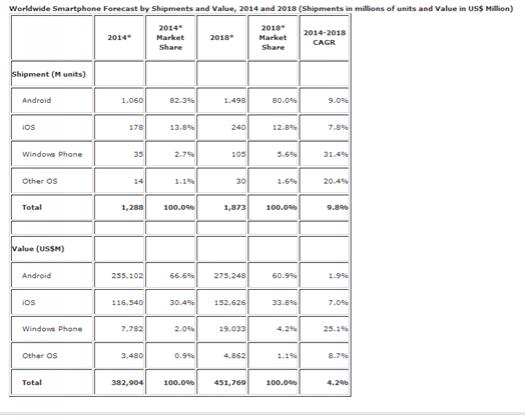Worldwide Smartphone Growth Forecast to Slow

According to a new mobile phone forecast from the International Data Corporation (IDC) Worldwide Quarterly Mobile Phone Tracker, worldwide smartphone shipments will reach a total of nearly 1.3 billion units in 2014, representing an increase of 26.3% over 2013. Looking ahead, IDC expects 1.4 billion smartphones to be shipped worldwide in 2015 for a 12.2% year-over-year growth rate. Slower annual growth continues throughout the forecast with unit shipments approaching 1.9 billion units in 2018, resulting in a 9.8% compound annual growth rate (CAGR) for the 2014"“2018 forecast period. Smartphone revenues reflect a starker picture, as they will be hard hit by the increasingly cutthroat nature of pricing, resulting in a 4.2% CAGR over the same forecast period.
"The impact of upstart Chinese players in the global market will be reflected in a race to the bottom when it comes to price. While premium phones aren't going anywhere, we are seeing increasingly better specs in more affordable smartphones. Consumers no longer have to go with a top-of-the-line handset to guarantee decent hardware quality or experience," said Melissa Chau, Senior Research Manager with IDC's Worldwide Quarterly Mobile Phone Tracker. "The biggest question now is how much lower can prices go?"
On a worldwide basis, smartphones are expected to have an average selling price (ASP) of US$297 worldwide in 2014, dropping to US$241 by 2018. Emerging markets like India will see much lower smartphone prices, as ASPs hit US$135 in 2014 and fall to US$102 by 2018. In contrast, ASPs in mature markets are not expected to change significantly and modestly higher shipment volumes will not drive up overall revenues as each generation of flagship phones shows less and less differentiation from its predecessors.
From an operating system perspective, Android devices will continue to drive shipment volumes while iOS devices drive revenues. By 2018, Android will control 80% of global smartphones shipped and 61% of revenues, while iOS will control only 13% of volumes and 34% of revenues. With Android volumes so dominant, it is no longer a possibility for new operating systems like Tizen and Firefox to compete on price alone "“ any underdog OS must bring a radically different appeal to gain any significant traction.
"As shipment volume slows, we expect greater attention to shift toward value trends," said Ramon Llamas, Research Manager with IDC's Mobile Phones team. "Apple's approach with premium pricing ensures a growing portion of overall revenues despite its declining market share. Meanwhile, Android's multi-faceted approach "“ with forked versions and low-cost Android One strategy "“ will produce mixed results, yet it allows deeper penetration into emerging markets. That can lead to additional pressure on its vendor partners, who will need to seek greater differentiation in terms of devices and experiences in the hyper-competitive smartphone market."

































